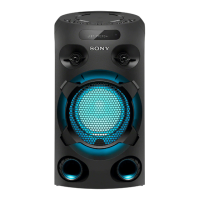What to do if Sony MHC-V02 displays “PROTECT 2 & 7”?
- SSteven MaloneJul 28, 2025
If the Sony Stereo System displays “PROTECT 2 & 7”, it is recommended to check and replace the speaker.

What to do if Sony MHC-V02 displays “PROTECT 2 & 7”?
If the Sony Stereo System displays “PROTECT 2 & 7”, it is recommended to check and replace the speaker.
What to do if Sony MHC-V02 Stereo System displays “PROTECT 1, 3, 4 & 8” after turning on?
If the Sony Stereo System displays “PROTECT 1, 3, 4 & 8” on the screen after turning the power on, replace the MOTHERBOARD mounted pc board.
| Speaker type | - |
|---|---|
| Speaker placement | Floor |
| Built-in amplifier | Yes |
| Number of woofer drivers | 1 |
| Number of tweeter drivers | 2 |
| Type | Home audio mini system |
| Control type | Buttons, Wireless |
| Display type | LED |
| Cassette deck | No |
| Product color | Black |
| Housing material | Plastic |
| Disc loading type | Top |
| Number of optical discs | 1 discs |
| USB 2.0 ports quantity | USB 2.0 ports have a data transmission speed of 480 Mbps, and are backwards compatible with USB 1.1 ports. You can connect all kinds of peripheral devices to them. |
| Quantity per pack | 1 pc(s) |
| RMS rated power | - W |
| Power source | AC |
| Power source type | AC, Battery |
| Power consumption (standby) | 0.5 W |
| Power consumption (typical) | 25 W |
| Bluetooth version | 4.2 |
| Coloration | Monochromatic |
| Bluetooth profiles | A2DP, AVRCP, SPP |
| Illumination location | Front |
| Analog signal format system | NTSC, PAL |
| Compatible operating systems | Android, iOS |
| Supported radio bands | Not supported |
| Recording on | USB |
| Disc types supported | CD, CD-R, CD-RW |
| Playback disc formats | CD audio |
| Audio formats supported | AAC, MP3, WAV, WMA |
| Volume control | Digital |
| Depth | 306 mm |
|---|---|
| Width | 281 mm |
| Height | 500 mm |
| Weight | 6000 g |
| Woofer diameter | 180 mm |
| Tweeter diameter | 40 mm |
Details audio output power and harmonic distortion for US models.
Covers FM tuning range, antenna requirements, and reception standards.
Outlines Bluetooth version, power class, profiles, codecs, and range.
Lists MP3, AAC, WMA, WAV formats with bit rates and sampling frequencies.
Includes power requirements, consumption, dimensions, mass, and operating temperature.
Guidelines for using and characteristics of unleaded solder in repairs.
Precautions for handling optical pick-up blocks to prevent damage.
Safety instructions for checking laser diode emission to prevent eye hazards.
Step-by-step overview of the unit's disassembly process.
Instructions for safely removing the unit's left and right side panels.
Guide for disassembling the top panel and rear section.
Procedure for accessing and removing the main motherboard.
Steps to remove the SMPS board and bottom chassis assembly.
Instructions for disassembling the front panel section.
Guide for removing the 18cm woofer speaker unit.
Checks display panel, LEDs, model info, and button functionality.
Resets all user settings and preset data to initial conditions.
How to view important data stored when a protection event occurred.
Resets all user settings to factory defaults for customer return.
Activation and release procedure for the shop display demonstration mode.
Procedure to verify the FM tuner's auto stop function with signal generator.
Troubleshooting flow for SMPS board voltage output issues.
Diagnostic flow for 'PROTECTX' errors related to the amplifier section.
Illustrates the signal paths for the RS Servo and USB interface.
Overview of the main processing and control blocks of the unit.
Shows the signal flow and components within the amplifier stage.
Illustrates the panel interface and power supply control blocks.
Detailed block diagram of the Switched-Mode Power Supply.
Visual guide to the physical placement of all circuit boards.
Printed wiring board layout showing components on the motherboard.
Printed wiring board layout for the unit's front panel.
Printed wiring board layout for the SMPS power supply board.
Visual breakdown of parts for the left and right panels.
Visual breakdown of parts for the rear panel section.
Visual breakdown of parts for the bottom chassis.
Visual breakdown of parts for the front panel assembly.
Visual breakdown of parts for the main speaker cabinet.
Visual breakdown of parts for the top panel assembly.
Comprehensive list of all electrical parts with numbers and descriptions.
